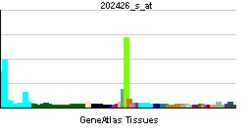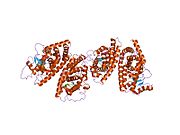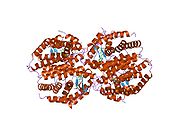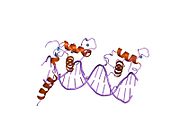- Retinoid X receptor alpha
-
Retinoid X receptor alpha (RXR-alpha), also known as NR2B1 (nuclear receptor subfamily 2, group B, member 1) is a nuclear receptor that in humans is encoded by the RXRA gene.[1]
Contents
Function
Retinoid X receptors (RXRs) and retinoic acid receptors (RARs), are nuclear receptors that mediate the biological effects of retinoids by their involvement in retinoic acid-mediated gene activation. These receptors exert their action by binding, as homodimers or heterodimers, to specific sequences in the promoters of target genes and regulating their transcription. The protein encoded by this gene is a member of the steroid and thyroid hormone receptor superfamily of transcription factors.[2]
Interactions
Retinoid X receptor alpha has been shown to interact with:
- BCL3,[3]
- BRD8,[4]
- CLOCK,[5]
- FXR[6]
- IGFBP3,[7]
- ITGB3BP,[8]
- LXR-β,[6]
- MyoD,[9]
- NCOA2,[10]
- NCOA3,[11]
- NCOA6,[12][13][14][15]
- NR4A1,[16]
- NFKBIB,[17]
- NPAS2,[5]
- NRIP1,[18][19]
- PPAR-γ,[20][21][22]
- POU2F1,[23][24]
- PPARGC1A,[25]
- RAR-α,[26][27]
- RNF8,[28]
- SHP,[29][30]
- TADA3L,[31]
- TBP,[32]
- TR-β,[33][34]
- TRIM24.[35][36] and
- VDR.[10][37]
See also
References
- ^ Mangelsdorf DJ, Ong ES, Dyck JA, Evans RM (May 1990). "Nuclear receptor that identifies a novel retinoic acid response pathway". Nature 345 (6272): 224–9. doi:10.1038/345224a0. PMID 2159111.
- ^ "Entrez Gene: RXRA retinoid X receptor, alpha". http://www.ncbi.nlm.nih.gov/sites/entrez?Db=gene&Cmd=ShowDetailView&TermToSearch=6256.
- ^ Na SY, Choi HS, Kim JW, Na DS, Lee JW (November 1998). "Bcl3, an IkappaB protein, as a novel transcription coactivator of the retinoid X receptor". J. Biol. Chem. 273 (47): 30933–8. doi:10.1074/jbc.273.47.30933. PMID 9812988.
- ^ Monden T, Kishi M, Hosoya T, Satoh T, Wondisford FE, Hollenberg AN, Yamada M, Mori M (October 1999). "p120 acts as a specific coactivator for 9-cis-retinoic acid receptor (RXR) on peroxisome proliferator-activated receptor-gamma/RXR heterodimers". Mol. Endocrinol. 13 (10): 1695–703. doi:10.1210/me.13.10.1695. PMID 10517671.
- ^ a b McNamara P, Seo SB, Rudic RD, Sehgal A, Chakravarti D, FitzGerald GA (June 2001). "Regulation of CLOCK and MOP4 by nuclear hormone receptors in the vasculature: a humoral mechanism to reset a peripheral clock". Cell 105 (7): 877–89. doi:10.1016/S0092-8674(01)00401-9. PMID 11439184.
- ^ a b Seol W, Choi HS, Moore DD (January 1995). "Isolation of proteins that interact specifically with the retinoid X receptor: two novel orphan receptors". Mol. Endocrinol. 9 (1): 72–85. doi:10.1210/me.9.1.72. PMID 7760852.
- ^ Liu B, Lee HY, Weinzimer SA, Powell DR, Clifford JL, Kurie JM, Cohen P (October 2000). "Direct functional interactions between insulin-like growth factor-binding protein-3 and retinoid X receptor-alpha regulate transcriptional signaling and apoptosis". J. Biol. Chem. 275 (43): 33607–13. doi:10.1074/jbc.M002547200. PMID 10874028.
- ^ Li D, Desai-Yajnik V, Lo E, Schapira M, Abagyan R, Samuels HH (October 1999). "NRIF3 is a novel coactivator mediating functional specificity of nuclear hormone receptors". Mol. Cell. Biol. 19 (10): 7191–202. PMC 84712. PMID 10490654. http://www.pubmedcentral.nih.gov/articlerender.fcgi?tool=pmcentrez&artid=84712.
- ^ Froeschlé A, Alric S, Kitzmann M, Carnac G, Auradé F, Rochette-Egly C, Bonnieu A (July 1998). "Retinoic acid receptors and muscle b-HLH proteins: partners in retinoid-induced myogenesis". Oncogene 16 (26): 3369–78. doi:10.1038/sj.onc.1201894. PMID 9692544.
- ^ a b Zhang C, Baudino TA, Dowd DR, Tokumaru H, Wang W, MacDonald PN (November 2001). "Ternary complexes and cooperative interplay between NCoA-62/Ski-interacting protein and steroid receptor coactivators in vitamin D receptor-mediated transcription". J. Biol. Chem. 276 (44): 40614–20. doi:10.1074/jbc.M106263200. PMID 11514567.
- ^ Chen H, Lin RJ, Schiltz RL, Chakravarti D, Nash A, Nagy L, Privalsky ML, Nakatani Y, Evans RM (August 1997). "Nuclear receptor coactivator ACTR is a novel histone acetyltransferase and forms a multimeric activation complex with P/CAF and CBP/p300". Cell 90 (3): 569–80. doi:10.1016/S0092-8674(00)80516-4. PMID 9267036.
- ^ Lee SK, Anzick SL, Choi JE, Bubendorf L, Guan XY, Jung YK, Kallioniemi OP, Kononen J, Trent JM, Azorsa D, Jhun BH, Cheong JH, Lee YC, Meltzer PS, Lee JW (November 1999). "A nuclear factor, ASC-2, as a cancer-amplified transcriptional coactivator essential for ligand-dependent transactivation by nuclear receptors in vivo". J. Biol. Chem. 274 (48): 34283–93. doi:10.1074/jbc.274.48.34283. PMID 10567404.
- ^ Lee SK, Jung SY, Kim YS, Na SY, Lee YC, Lee JW (February 2001). "Two distinct nuclear receptor-interaction domains and CREB-binding protein-dependent transactivation function of activating signal cointegrator-2". Mol. Endocrinol. 15 (2): 241–54. doi:10.1210/me.15.2.241. PMID 11158331.
- ^ Kong HJ, Park MJ, Hong S, Yu HJ, Lee YC, Choi YH, Cheong J (November 2003). "Hepatitis B virus X protein regulates transactivation activity and protein stability of the cancer-amplified transcription coactivator ASC-2". Hepatology 38 (5): 1258–66. doi:10.1053/jhep.2003.50451. PMID 14578865.
- ^ Ko L, Cardona GR, Iwasaki T, Bramlett KS, Burris TP, Chin WW (January 2002). "Ser-884 adjacent to the LXXLL motif of coactivator TRBP defines selectivity for ERs and TRs". Mol. Endocrinol. 16 (1): 128–40. doi:10.1210/me.16.1.128. PMID 11773444.
- ^ Lin B, Kolluri SK, Lin F, Liu W, Han YH, Cao X, Dawson MI, Reed JC, Zhang XK (February 2004). "Conversion of Bcl-2 from protector to killer by interaction with nuclear orphan receptor Nur77/TR3". Cell 116 (4): 527–40. doi:10.1016/S0092-8674(04)00162-X. PMID 14980220.
- ^ Na SY, Kim HJ, Lee SK, Choi HS, Na DS, Lee MO, Chung M, Moore DD, Lee JW (February 1998). "IkappaBbeta interacts with the retinoid X receptor and inhibits retinoid-dependent transactivation in lipopolysaccharide-treated cells". J. Biol. Chem. 273 (6): 3212–5. doi:10.1074/jbc.273.6.3212. PMID 9452433.
- ^ Farooqui M, Franco PJ, Thompson J, Kagechika H, Chandraratna RA, Banaszak L, Wei LN (February 2003). "Effects of retinoid ligands on RIP140: molecular interaction with retinoid receptors and biological activity". Biochemistry 42 (4): 971–9. doi:10.1021/bi020497k. PMID 12549917.
- ^ L'Horset F, Dauvois S, Heery DM, Cavaillès V, Parker MG (November 1996). "RIP-140 interacts with multiple nuclear receptors by means of two distinct sites". Mol. Cell. Biol. 16 (11): 6029–36. PMC 231605. PMID 8887632. http://www.pubmedcentral.nih.gov/articlerender.fcgi?tool=pmcentrez&artid=231605.
- ^ Tontonoz P, Graves RA, Budavari AI, Erdjument-Bromage H, Lui M, Hu E, Tempst P, Spiegelman BM (December 1994). "Adipocyte-specific transcription factor ARF6 is a heterodimeric complex of two nuclear hormone receptors, PPAR gamma and RXR alpha". Nucleic Acids Res. 22 (25): 5628–34. doi:10.1093/nar/22.25.5628. PMC 310126. PMID 7838715. http://www.pubmedcentral.nih.gov/articlerender.fcgi?tool=pmcentrez&artid=310126.
- ^ Berger J, Patel HV, Woods J, Hayes NS, Parent SA, Clemas J, Leibowitz MD, Elbrecht A, Rachubinski RA, Capone JP, Moller DE (April 2000). "A PPARgamma mutant serves as a dominant negative inhibitor of PPAR signaling and is localized in the nucleus". Mol. Cell. Endocrinol. 162 (1–2): 57–67. doi:10.1016/S0303-7207(00)00211-2. PMID 10854698.
- ^ Gampe RT, Montana VG, Lambert MH, Miller AB, Bledsoe RK, Milburn MV, Kliewer SA, Willson TM, Xu HE (March 2000). "Asymmetry in the PPARgamma/RXRalpha crystal structure reveals the molecular basis of heterodimerization among nuclear receptors". Mol. Cell 5 (3): 545–55. doi:10.1016/S1097-2765(00)80448-7. PMID 10882139.
- ^ Préfontaine GG, Walther R, Giffin W, Lemieux ME, Pope L, Haché RJ (September 1999). "Selective binding of steroid hormone receptors to octamer transcription factors determines transcriptional synergism at the mouse mammary tumor virus promoter". J. Biol. Chem. 274 (38): 26713–9. doi:10.1074/jbc.274.38.26713. PMID 10480874.
- ^ Kakizawa T, Miyamoto T, Ichikawa K, Kaneko A, Suzuki S, Hara M, Nagasawa T, Takeda T, Mori J, Kumagai M, Hashizume K (July 1999). "Functional interaction between Oct-1 and retinoid X receptor". J. Biol. Chem. 274 (27): 19103–8. doi:10.1074/jbc.274.27.19103. PMID 10383413.
- ^ Delerive P, Wu Y, Burris TP, Chin WW, Suen CS (February 2002). "PGC-1 functions as a transcriptional coactivator for the retinoid X receptors". J. Biol. Chem. 277 (6): 3913–7. doi:10.1074/jbc.M109409200. PMID 11714715.
- ^ Benkoussa M, Brand C, Delmotte MH, Formstecher P, Lefebvre P (July 2002). "Retinoic acid receptors inhibit AP1 activation by regulating extracellular signal-regulated kinase and CBP recruitment to an AP1-responsive promoter". Mol. Cell. Biol. 22 (13): 4522–34. doi:10.1128/MCB.22.13.4522-4534.2002. PMC 133906. PMID 12052862. http://www.pubmedcentral.nih.gov/articlerender.fcgi?tool=pmcentrez&artid=133906.
- ^ Bugge TH, Pohl J, Lonnoy O, Stunnenberg HG (April 1992). "RXR alpha, a promiscuous partner of retinoic acid and thyroid hormone receptors". EMBO J. 11 (4): 1409–18. PMC 556590. PMID 1314167. http://www.pubmedcentral.nih.gov/articlerender.fcgi?tool=pmcentrez&artid=556590.
- ^ Takano Y, Adachi S, Okuno M, Muto Y, Yoshioka T, Matsushima-Nishiwaki R, Tsurumi H, Ito K, Friedman SL, Moriwaki H, Kojima S, Okano Y (April 2004). "The RING finger protein, RNF8, interacts with retinoid X receptor alpha and enhances its transcription-stimulating activity". J. Biol. Chem. 279 (18): 18926–34. doi:10.1074/jbc.M309148200. PMID 14981089.
- ^ Lee YK, Dell H, Dowhan DH, Hadzopoulou-Cladaras M, Moore DD (January 2000). "The orphan nuclear receptor SHP inhibits hepatocyte nuclear factor 4 and retinoid X receptor transactivation: two mechanisms for repression". Mol. Cell. Biol. 20 (1): 187–95. doi:10.1128/MCB.20.1.187-195.2000. PMC 85074. PMID 10594021. http://www.pubmedcentral.nih.gov/articlerender.fcgi?tool=pmcentrez&artid=85074.
- ^ Brendel C, Schoonjans K, Botrugno OA, Treuter E, Auwerx J (September 2002). "The small heterodimer partner interacts with the liver X receptor alpha and represses its transcriptional activity". Mol. Endocrinol. 16 (9): 2065–76. doi:10.1210/me.2001-0194. PMID 12198243.
- ^ Zeng M, Kumar A, Meng G, Gao Q, Dimri G, Wazer D, Band H, Band V (November 2002). "Human papilloma virus 16 E6 oncoprotein inhibits retinoic X receptor-mediated transactivation by targeting human ADA3 coactivator". J. Biol. Chem. 277 (47): 45611–8. doi:10.1074/jbc.M208447200. PMID 12235159.
- ^ Schulman IG, Chakravarti D, Juguilon H, Romo A, Evans RM (August 1995). "Interactions between the retinoid X receptor and a conserved region of the TATA-binding protein mediate hormone-dependent transactivation". Proc. Natl. Acad. Sci. U.S.A. 92 (18): 8288–92. doi:10.1073/pnas.92.18.8288. PMC 41142. PMID 7667283. http://www.pubmedcentral.nih.gov/articlerender.fcgi?tool=pmcentrez&artid=41142.
- ^ Monden T, Wondisford FE, Hollenberg AN (November 1997). "Isolation and characterization of a novel ligand-dependent thyroid hormone receptor-coactivating protein". J. Biol. Chem. 272 (47): 29834–41. doi:10.1074/jbc.272.47.29834. PMID 9368056.
- ^ Jeyakumar M, Tanen MR, Bagchi MK (June 1997). "Analysis of the functional role of steroid receptor coactivator-1 in ligand-induced transactivation by thyroid hormone receptor". Mol. Endocrinol. 11 (6): 755–67. doi:10.1210/me.11.6.755. PMID 9171239.
- ^ Thénot S, Henriquet C, Rochefort H, Cavaillès V (May 1997). "Differential interaction of nuclear receptors with the putative human transcriptional coactivator hTIF1". J. Biol. Chem. 272 (18): 12062–8. doi:10.1074/jbc.272.18.12062. PMID 9115274.
- ^ Lee WY, Noy N (February 2002). "Interactions of RXR with coactivators are differentially mediated by helix 11 of the receptor's ligand binding domain". Biochemistry 41 (8): 2500–8. doi:10.1021/bi011764. PMID 11851396.
- ^ Baudino, T A; Kraichely D M, Jefcoat S C, Winchester S K, Partridge N C, MacDonald P N (Jun. 1998). "Isolation and characterization of a novel coactivator protein, NCoA-62, involved in vitamin D-mediated transcription". J. Biol. Chem. (UNITED STATES) 273 (26): 16434–41. doi:10.1074/jbc.273.26.16434. ISSN 0021-9258. PMID 9632709.
Further reading
- Szanto A, Narkar V, Shen Q, et al. (2005). "Retinoid X receptors: X-ploring their (patho)physiological functions". Cell Death Differ. 11 Suppl 2: S126–43. doi:10.1038/sj.cdd.4401533. PMID 15608692.
- Heyman RA, Mangelsdorf DJ, Dyck JA, et al. (1992). "9-cis retinoic acid is a high affinity ligand for the retinoid X receptor". Cell 68 (2): 397–406. doi:10.1016/0092-8674(92)90479-V. PMID 1310260.
- Kliewer SA, Umesono K, Mangelsdorf DJ, Evans RM (1992). "Retinoid X receptor interacts with nuclear receptors in retinoic acid, thyroid hormone and vitamin D3 signalling". Nature 355 (6359): 446–9. doi:10.1038/355446a0. PMID 1310351.
- Kliewer SA, Umesono K, Heyman RA, et al. (1992). "Retinoid X receptor-COUP-TF interactions modulate retinoic acid signaling". Proc. Natl. Acad. Sci. U.S.A. 89 (4): 1448–52. doi:10.1073/pnas.89.4.1448. PMC 48468. PMID 1311101. http://www.pubmedcentral.nih.gov/articlerender.fcgi?tool=pmcentrez&artid=48468.
- Bugge TH, Pohl J, Lonnoy O, Stunnenberg HG (1992). "RXR alpha, a promiscuous partner of retinoic acid and thyroid hormone receptors". EMBO J. 11 (4): 1409–18. PMC 556590. PMID 1314167. http://www.pubmedcentral.nih.gov/articlerender.fcgi?tool=pmcentrez&artid=556590.
- Berrodin TJ, Marks MS, Ozato K, et al. (1992). "Heterodimerization among thyroid hormone receptor, retinoic acid receptor, retinoid X receptor, chicken ovalbumin upstream promoter transcription factor, and an endogenous liver protein". Mol. Endocrinol. 6 (9): 1468–78. doi:10.1210/me.6.9.1468. PMID 1331778.
- Mangelsdorf DJ, Umesono K, Kliewer SA, et al. (1991). "A direct repeat in the cellular retinol-binding protein type II gene confers differential regulation by RXR and RAR". Cell 66 (3): 555–61. doi:10.1016/0092-8674(81)90018-0. PMID 1651173.
- Mangelsdorf DJ, Ong ES, Dyck JA, Evans RM (1990). "Nuclear receptor that identifies a novel retinoic acid response pathway". Nature 345 (6272): 224–9. doi:10.1038/345224a0. PMID 2159111.
- Oñate SA, Tsai SY, Tsai MJ, O'Malley BW (1995). "Sequence and characterization of a coactivator for the steroid hormone receptor superfamily". Science 270 (5240): 1354–7. doi:10.1126/science.270.5240.1354. PMID 7481822.
- Chen JD, Evans RM (1995). "A transcriptional co-repressor that interacts with nuclear hormone receptors". Nature 377 (6548): 454–7. doi:10.1038/377454a0. PMID 7566127.
- Schulman IG, Chakravarti D, Juguilon H, et al. (1995). "Interactions between the retinoid X receptor and a conserved region of the TATA-binding protein mediate hormone-dependent transactivation". Proc. Natl. Acad. Sci. U.S.A. 92 (18): 8288–92. doi:10.1073/pnas.92.18.8288. PMC 41142. PMID 7667283. http://www.pubmedcentral.nih.gov/articlerender.fcgi?tool=pmcentrez&artid=41142.
- Perlmann T, Jansson L (1995). "A novel pathway for vitamin A signaling mediated by RXR heterodimerization with NGFI-B and NURR1". Genes Dev. 9 (7): 769–82. doi:10.1101/gad.9.7.769. PMID 7705655.
- Rastinejad F, Perlmann T, Evans RM, Sigler PB (1995). "Structural determinants of nuclear receptor assembly on DNA direct repeats". Nature 375 (6528): 203–11. doi:10.1038/375203a0. PMID 7746322.
- Forman BM, Umesono K, Chen J, Evans RM (1995). "Unique response pathways are established by allosteric interactions among nuclear hormone receptors". Cell 81 (4): 541–50. doi:10.1016/0092-8674(95)90075-6. PMID 7758108.
- Seol W, Choi HS, Moore DD (1995). "Isolation of proteins that interact specifically with the retinoid X receptor: two novel orphan receptors". Mol. Endocrinol. 9 (1): 72–85. doi:10.1210/me.9.1.72. PMID 7760852.
- Bourguet W, Ruff M, Chambon P, et al. (1995). "Crystal structure of the ligand-binding domain of the human nuclear receptor RXR-alpha". Nature 375 (6530): 377–82. doi:10.1038/375377a0. PMID 7760929.
- Lee JW, Choi HS, Gyuris J, et al. (1995). "Two classes of proteins dependent on either the presence or absence of thyroid hormone for interaction with the thyroid hormone receptor". Mol. Endocrinol. 9 (2): 243–54. doi:10.1210/me.9.2.243. PMID 7776974.
- Tontonoz P, Graves RA, Budavari AI, et al. (1995). "Adipocyte-specific transcription factor ARF6 is a heterodimeric complex of two nuclear hormone receptors, PPAR gamma and RXR alpha". Nucleic Acids Res. 22 (25): 5628–34. doi:10.1093/nar/22.25.5628. PMC 310126. PMID 7838715. http://www.pubmedcentral.nih.gov/articlerender.fcgi?tool=pmcentrez&artid=310126.
- Lee JW, Ryan F, Swaffield JC, et al. (1995). "Interaction of thyroid-hormone receptor with a conserved transcriptional mediator". Nature 374 (6517): 91–4. doi:10.1038/374091a0. PMID 7870181.
- Lee MS, Sem DS, Kliewer SA, et al. (1994). "NMR assignments and secondary structure of the retinoid X receptor alpha DNA-binding domain. Evidence for the novel C-terminal helix". Eur. J. Biochem. 224 (2): 639–50. doi:10.1111/j.1432-1033.1994.00639.x. PMID 7925381.
External links
This article incorporates text from the United States National Library of Medicine, which is in the public domain.
PDB gallery 1by4: STRUCTURE AND MECHANISM OF THE HOMODIMERIC ASSEMBLY OF THE RXR ON DNA1dkf: CRYSTAL STRUCTURE OF A HETERODIMERIC COMPLEX OF RAR AND RXR LIGAND-BINDING DOMAINS1dsz: STRUCTURE OF THE RXR/RAR DNA-BINDING DOMAIN HETERODIMER IN COMPLEX WITH THE RETINOIC ACID RESPONSE ELEMENT DR11fby: CRYSTAL STRUCTURE OF THE HUMAN RXR ALPHA LIGAND BINDING DOMAIN BOUND TO 9-CIS RETINOIC ACID1fm6: THE 2.1 ANGSTROM RESOLUTION CRYSTAL STRUCTURE OF THE HETERODIMER OF THE HUMAN RXRALPHA AND PPARGAMMA LIGAND BINDING DOMAINS RESPECTIVELY BOUND WITH 9-CIS RETINOIC ACID AND ROSIGLITAZONE AND CO-ACTIVATOR PEPTIDES.1fm9: THE 2.1 ANGSTROM RESOLUTION CRYSTAL STRUCTURE OF THE HETERODIMER OF THE HUMAN RXRALPHA AND PPARGAMMA LIGAND BINDING DOMAINS RESPECTIVELY BOUND WITH 9-CIS RETINOIC ACID AND GI262570 AND CO-ACTIVATOR PEPTIDES.1g1u: THE 2.5 ANGSTROM RESOLUTION CRYSTAL STRUCTURE OF THE RXRALPHA LIGAND BINDING DOMAIN IN TETRAMER IN THE ABSENCE OF LIGAND1g5y: THE 2.0 ANGSTROM RESOLUTION CRYSTAL STRUCTURE OF THE RXRALPHA LIGAND BINDING DOMAIN TETRAMER IN THE PRESENCE OF A NON-ACTIVATING RETINOIC ACID ISOMER.1k74: The 2.3 Angstrom resolution crystal structure of the heterodimer of the human PPARgamma and RXRalpha ligand binding domains respectively bound with GW409544 and 9-cis retinoic acid and co-activator peptides.1lbd: LIGAND-BINDING DOMAIN OF THE HUMAN NUCLEAR RECEPTOR RXR-ALPHA1mv9: Crystal Structure of the human RXR alpha ligand binding domain bound to the eicosanoid DHA (Docosa Hexaenoic Acid) and a coactivator peptide1mvc: Crystal structure of the human RXR alpha ligand binding domain bound to the synthetic agonist compound BMS 649 and a coactivator peptide1mzn: CRYSTAL STRUCTURE at 1.9 ANGSTROEMS RESOLUTION OF THE HOMODIMER OF HUMAN RXR ALPHA LIGAND BINDING DOMAIN BOUND TO THE SYNTHETIC AGONIST COMPOUND BMS 649 AND A COACTIVATOR PEPTIDE1r0n: Crystal Structure of Heterodimeric Ecdsyone receptor DNA binding complex1rdt: Crystal Structure of a new rexinoid bound to the RXRalpha ligand binding doamin in the RXRalpha/PPARgamma heterodimer1rxr: HIGH RESOLUTION SOLUTION STRUCTURE OF THE RETINOID X RECEPTOR DNA BINDING DOMAIN, NMR, 20 STRUCTURE1xdk: Crystal Structure of the RARbeta/RXRalpha Ligand Binding Domain Heterodimer in Complex with 9-cis Retinoic Acid and a Fragment of the TRAP220 Coactivator1xls: Crystal structure of the mouse CAR/RXR LBD heterodimer bound to TCPOBOP and 9cRA and a TIF2 peptide containg the third LXXLL motifs1xv9: crystal structure of CAR/RXR heterodimer bound with SRC1 peptide, fatty acid, and 5b-pregnane-3,20-dione.1xvp: crystal structure of CAR/RXR heterodimer bound with SRC1 peptide, fatty acid and CITCO1ynw: Crystal Structure of Vitmain D Receptor and 9-cis Retinoic Acid Receptor DNA-Binding Domains Bound to a DR3 Response Element2acl: Liver X-Receptor alpha Ligand Binding Domain with SB3139872nll: RETINOID X RECEPTOR-THYROID HORMONE RECEPTOR DNA-BINDING DOMAIN HETERODIMER BOUND TO THYROID RESPONSE ELEMENT DNATranscription factors and intracellular receptors (1) Basic domains (1.1) Basic leucine zipper (bZIP)Activating transcription factor (AATF, 1, 2, 3, 4, 5, 6, 7) · AP-1 (c-Fos, FOSB, FOSL1, FOSL2, JDP2, c-Jun, JUNB, JUND) · BACH (1, 2) · BATF · BLZF1 · C/EBP (α, β, γ, δ, ε, ζ) · CREB (1, 3, L1) · CREM · DBP · DDIT3 · GABPA · HLF · MAF (B, F, G, K) · NFE (2, L1, L2, L3) · NFIL3 · NRL · NRF (1, 2, 3) · XBP1(1.2) Basic helix-loop-helix (bHLH)ATOH1 · AhR · AHRR · ARNT · ASCL1 · BHLHB2 · BMAL (ARNTL, ARNTL2) · CLOCK · EPAS1 · FIGLA · HAND (1, 2) · HES (5, 6) · HEY (1, 2, L) · HES1 · HIF (1A, 3A) · ID (1, 2, 3, 4) · LYL1 · MESP2 · MXD4 · MYCL1 · MYCN · Myogenic regulatory factors (MyoD, Myogenin, MYF5, MYF6) · Neurogenins (1, 2, 3) · NeuroD (1, 2) · NPAS (1, 2, 3) · OLIG (1, 2) · Pho4 · Scleraxis · SIM (1, 2) · TAL (1, 2) · Twist · USF1(1.3) bHLH-ZIP(1.4) NF-1(1.5) RF-X(1.6) Basic helix-span-helix (bHSH)(2) Zinc finger DNA-binding domains (2.1) Nuclear receptor (Cys4)subfamily 1 (Thyroid hormone (α, β), CAR, FXR, LXR (α, β), PPAR (α, β/δ, γ), PXR, RAR (α, β, γ), ROR (α, β, γ), Rev-ErbA (α, β), VDR)
subfamily 2 (COUP-TF (I, II), Ear-2, HNF4 (α, γ), PNR, RXR (α, β, γ), Testicular receptor (2, 4), TLX)
subfamily 3 (Steroid hormone (Androgen, Estrogen (α, β), Glucocorticoid, Mineralocorticoid, Progesterone), Estrogen related (α, β, γ))
subfamily 4 NUR (NGFIB, NOR1, NURR1) · subfamily 5 (LRH-1, SF1) · subfamily 6 (GCNF) · subfamily 0 (DAX1, SHP)(2.2) Other Cys4(2.3) Cys2His2General transcription factors (TFIIA, TFIIB, TFIID, TFIIE (1, 2), TFIIF (1, 2), TFIIH (1, 2, 4, 2I, 3A, 3C1, 3C2))
ATBF1 · BCL (6, 11A, 11B) · CTCF · E4F1 · EGR (1, 2, 3, 4) · ERV3 · GFI1 · GLI-Krüppel family (1, 2, 3, REST, S2, YY1) · HIC (1, 2) · HIVEP (1, 2, 3) · IKZF (1, 2, 3) · ILF (2, 3) · KLF (2, 3, 4, 5, 6, 7, 8, 9, 10, 11, 12, 13, 14, 15, 17) · MTF1 · MYT1 · OSR1 · PRDM9 · SALL (1, 2, 3, 4) · SP (1, 2, 4, 7, 8) · TSHZ3 · WT1 · Zbtb7 (7A, 7B) · ZBTB (16, 17, 20, 32, 33, 40) · zinc finger (3, 7, 9, 10, 19, 22, 24, 33B, 34, 35, 41, 43, 44, 51, 74, 143, 146, 148, 165, 202, 217, 219, 238, 239, 259, 267, 268, 281, 295, 300, 318, 330, 346, 350, 365, 366, 384, 423, 451, 452, 471, 593, 638, 644, 649, 655)(2.4) Cys6(2.5) Alternating composition(3) Helix-turn-helix domains (3.1) HomeodomainARX · CDX (1, 2) · CRX · CUTL1 · DBX (1, 2) · DLX (3, 4, 5) · EMX2 · EN (1, 2) · FHL (1, 2, 3) · HESX1 · HHEX · HLX · Homeobox (A1, A2, A3, A4, A5, A7, A9, A10, A11, A13, B1, B2, B3, B4, B5, B6, B7, B8, B9, B13, C4, C5, C6, C8, C9, C10, C11, C12, C13, D1, D3, D4, D8, D9, D10, D11, D12, D13) · HOPX · IRX (1, 2, 3, 4, 5, 6, MKX) · LMX (1A, 1B) · MEIS (1, 2) · MEOX2 · MNX1 · MSX (1, 2) · NANOG · NKX (2-1, 2-2, 2-3, 2-5, 3-1, 3-2, 6-1, 6-2) · NOBOX · PBX (1, 2, 3) · PHF (1, 3, 6, 8, 10, 16, 17, 20, 21A) · PHOX (2A, 2B) · PITX (1, 2, 3) · POU domain (PIT-1, BRN-3: A, B, C, Octamer transcription factor: 1, 2, 3/4, 6, 7, 11) · OTX (1, 2) · PDX1 · SATB2 · SHOX2 · VAX1 · ZEB (1, 2)(3.2) Paired box(3.3) Fork head / winged helix(3.4) Heat Shock Factors(3.5) Tryptophan clusters(3.6) TEA domain(4) β-Scaffold factors with minor groove contacts (4.1) Rel homology region(4.2) STAT(4.3) p53(4.4) MADS box(4.6) TATA binding proteins(4.7) High-mobility group(4.10) Cold-shock domainCSDA, YBX1(4.11) Runt(0) Other transcription factors (0.2) HMGI(Y)(0.3) Pocket domain(0.6) MiscellaneousCategories:- Human proteins
- Intracellular receptors
- Transcription factors
- Chromosome 9 gene stubs
Wikimedia Foundation. 2010.


























